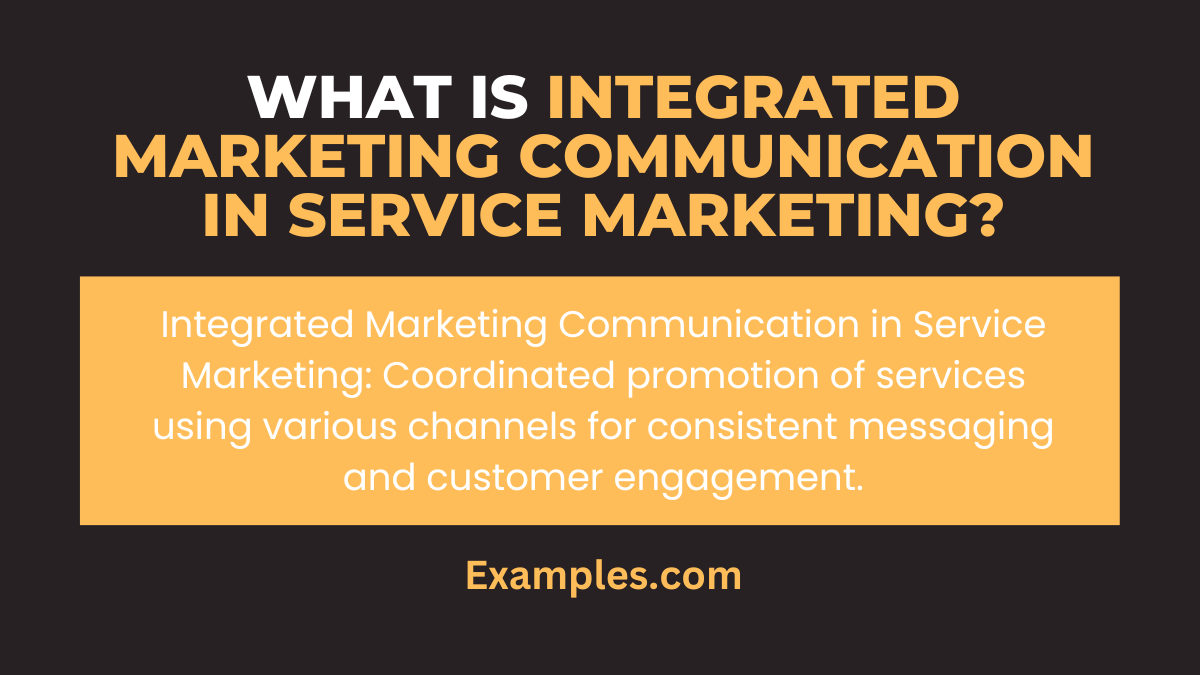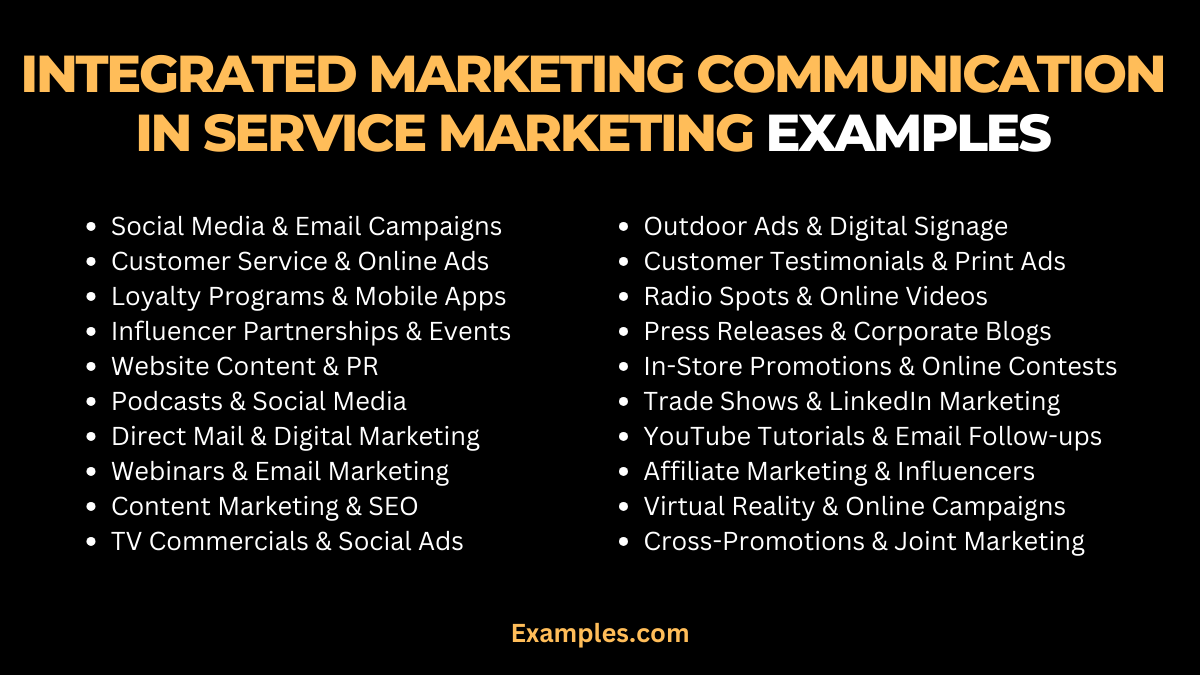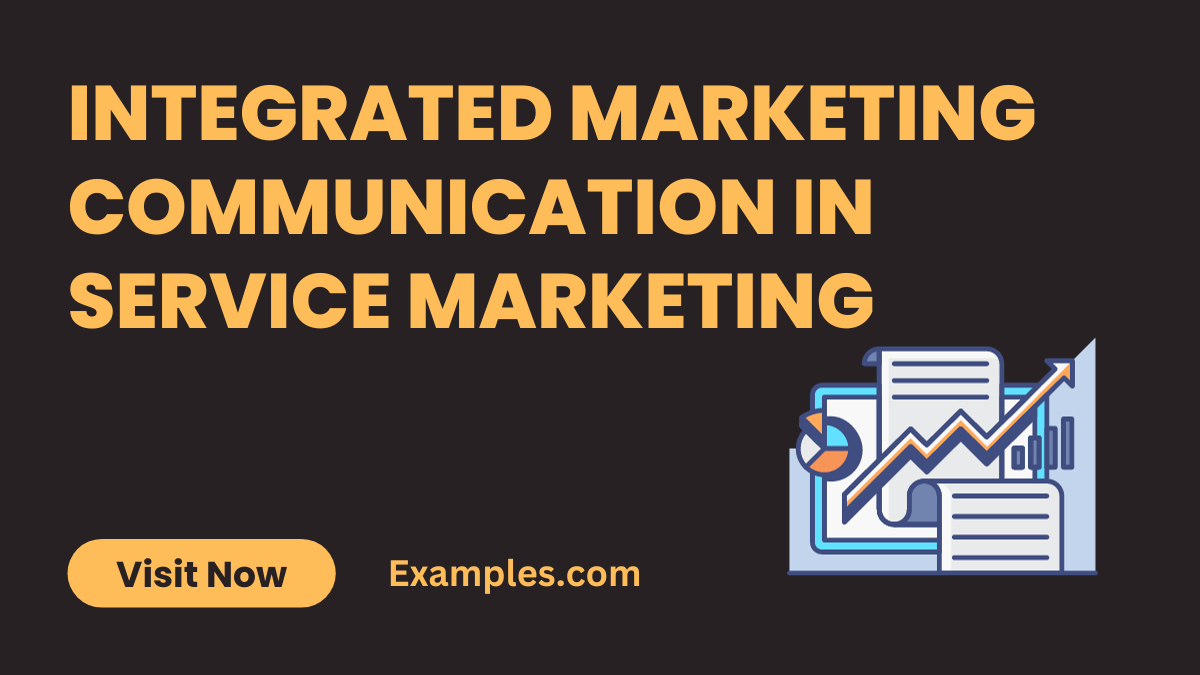Integrated Marketing Communication in Service Marketing
Integrated Marketing Communication (IMC) in service marketing is a multifaceted approach that synchronizes various promotional tools to provide a seamless customer experience. This comprehensive guide delves into how IMC enhances service marketing, with practical Communication Examples illustrating its effectiveness. From strategies to execution, this guide is designed to offer insights into integrating messaging across channels to effectively reach and engage target audiences in the service sector.
What is Integrated Marketing Communication in Service Marketing? – Meaning

Integrated Marketing Communication in service marketing refers to the strategic, coordinated use of different Marketing Communication Examples and channels to deliver a consistent and compelling brand message. It aligns advertising, sales promotion, public relations, and direct marketing efforts, ensuring they work together harmoniously. The goal is to provide a unified voice and message across all customer touchpoints, enhancing the overall impact of marketing campaigns in the service industry.
What is the Best Example of Integrated Marketing Communication in Service Marketing?

A prime example of Integrated Marketing Communication in service marketing can be seen in a company that seamlessly blends social media campaigns, email marketing, and in-store promotions. For instance, a hotel chain might launch a themed promotional campaign across various platforms. It would use social media for awareness, email marketing for personalized offers, and in-store displays to reinforce the campaign theme. This coordinated effort ensures a consistent brand experience, from online engagement to the physical interaction at the hotel, exemplifying effective IMC in action.
20 Integrated Marketing Communication in Service Marketing Examples

Integrated Marketing Communication (IMC) in service marketing is crucial for creating cohesive brand experiences. By blending traditional and digital channels, businesses can effectively communicate their value proposition. This list provides 20 unique and impactful examples of IMC in action, each demonstrating how coordinated messaging across different platforms can enhance customer engagement and brand loyalty. From social media campaigns to in-store promotions, these examples illustrate the power of a well-executed IMC strategy.
- Social Media and Email Campaigns: A retail store launches a new product line simultaneously on social media and through email newsletters. This dual approach ensures consistent messaging and broad reach.
- Customer Service and Online Advertising: A telecom company aligns its customer service ethos with its online ads, promoting reliability and quick response times across platforms.
- Loyalty Programs and Mobile Apps: A coffee shop integrates its loyalty program with a mobile app, offering personalized deals and rewards, ensuring a seamless customer experience.
- Influencer Partnerships and Event Marketing: A beauty brand collaborates with influencers for a product launch event, creating buzz both online and offline.
- Website Content and Public Relations: A tech firm aligns its website content with PR activities, ensuring consistent messaging about its innovative products.
- Podcasts and Social Media: A financial services company sponsors a popular podcast and promotes it on social media, reaching different audience segments.
- Direct Mail and Digital Marketing: A real estate agency combines direct mail campaigns with digital marketing efforts to target potential clients effectively.
- Webinars and Email Marketing: An educational institution hosts webinars and uses email marketing to invite and follow up with participants.
- Content Marketing and SEO: A travel agency uses blog content to boost SEO, while ensuring the content aligns with their overall marketing message.
- TV Commercials and Social Media Ads: A car manufacturer aligns its TV commercials with social media ads, maintaining a consistent brand story.
- Outdoor Advertising and Digital Signage: A restaurant uses similar visuals in outdoor advertising and digital signage for brand consistency.
- Customer Testimonials and Print Ads: A healthcare provider uses customer testimonials in both online platforms and print ads to build trust.
- Radio Spots and Online Videos: A retail chain aligns its radio advertisements with online video content for a unified promotional message.
- Press Releases and Corporate Blogs: A tech startup synchronizes its press releases with blog posts to keep messaging consistent.
- In-Store Promotions and Online Contests: A fashion retailer runs in-store promotions that are echoed in online contests, engaging customers across channels.
- Trade Shows and LinkedIn Marketing: A B2B company leverages its presence in trade shows and promotes it through LinkedIn marketing for professional outreach.
- YouTube Tutorials and Email Follow-ups: A beauty brand creates YouTube tutorials and uses email follow-ups to deepen customer engagement.
- Affiliate Marketing and Social Media Influencers: An e-commerce platform combines affiliate marketing strategies with social media influencers for broader reach.
- Virtual Reality Experiences and Online Campaigns: A gaming company integrates virtual reality experiences in its online campaigns for immersive marketing.
- Cross-Promotions and Joint Marketing Efforts: Two complementary service providers, like a gym and a health food store, engage in cross-promotions and joint marketing efforts for mutual benefit.
Integrated Marketing Communication in Service Marketing Role
Integrated Marketing Communication (IMC) plays a crucial role in unifying a brand’s voice across multiple channels. By integrating What does Integrated Marketing Communications Include?, the approach ensures that every marketing effort contributes coherently to the brand’s overall objectives. Here are five distinct examples demonstrating the role of IMC in service marketing:
- Unified Brand Messaging: A hotel chain uses consistent branding across its website, brochures, and social media.
Example: “Experience luxury and comfort at every touchpoint with us.” - Consistent Customer Experience: A telecom company aligns its advertising, customer service, and in-store experience.
Example: “Enjoy seamless service, whether online, on-call, or in our stores.” - Integrated Online and Offline Campaigns: A bank combines digital advertising with community events for holistic brand promotion.
Example: “Join us online and locally to learn about smarter banking.” - Synchronized Sales and Marketing Teams: A software company ensures its sales pitches align with marketing messages.
Example: “Our team delivers the innovation our marketing promises.” - Aligned Employee and External Communications: A healthcare provider trains its staff to communicate consistent health messages.
Example: “Our team is dedicated to your health, as our campaigns suggest.”
Integrated Marketing Communication in Service Marketing Plan
A well-crafted IMC plan in service marketing strategically aligns various communication methods to achieve marketing goals effectively. Incorporating Components of Integrated Marketing Communications and Functions of Integrated Marketing Communications, these plans are pivotal for cohesive brand messaging. Below are five unique examples:
- Digital and Traditional Media Mix: A retail store combines online ads with print media for broader reach.
Example: “Discover our products online and in your favorite magazines.” - Customer Feedback Integration: A travel agency uses customer reviews in its marketing materials.
Example: “Your feedback is our advertisement.” - Event Marketing and Social Media Synergy: A music festival promotes through social media and local events.
Example: “Join the buzz online and at our pre-festival events.” - Cross-Promotion with Partners: A fitness app collaborates with health food brands for joint promotions.
Example: “Team up with us for a healthier lifestyle, in collaboration with [Brand].” - Educational Content in Advertising: An insurance company uses informative content in its ads.
Example: “Learn about securing your future with our latest ad series.”
Download IMC in Service Marketing for Product Promotion
Integrated Marketing Communication in Service Digital Marketing
Effective digital marketing in the service sector requires a unified approach through Integrated Marketing Communication Degrees (IMC). These examples highlight how integrating various digital channels can enhance brand messaging and customer engagement.
- Beauty Salon Campaigns: A salon promotes a new service via synchronized email campaigns and social media posts, ensuring consistent messaging and wider reach.
- Legal Firm’s SEO and PPC Strategy: A legal firm combines SEO-optimized blog content with PPC ads on similar keywords, maximizing online visibility.
- Tech Product Virtual Launch: A tech company integrates digital advertising with an online product launch, amplifying event engagement across platforms like LinkedIn and Google Ads.
- Fitness Platform’s Cross-Platform Content: A fitness service shares consistent workout tips across its website, YouTube, and social media, maintaining a unified brand voice.
- Travel Agency’s Influencer Strategy: A travel agency teams up with influencers to promote travel packages, simultaneously highlighted through Instagram and Facebook stories for cohesive storytelling.
Integrated Marketing Communication in Service Marketing Brand
Integrated Marketing Communication (IMC) is key in developing a strong service marketing brand. It aligns various communication channels for consistent brand messaging and enhanced customer engagement.
- Brand Identity Consistency: IMC ensures uniform brand identity across channels, strengthening recognition. For more, see IMC Guide.
- Boosting Customer Loyalty: Effective engagement through IMC leads to increased loyalty. Insights are available at IMC Explanation.
- Strategic Multi-Channel Messaging: IMC tailors messages for diverse customer segments, Improving Communication Importance.
What are the Components of Integrated Marketing Communication in Service Marketing?
Integrated Marketing Communication (IMC) in service marketing is essential for ensuring that all forms of messaging and communication are harmoniously integrated. These components, working together, form the backbone of successful Integrated Marketing Communication Strategies, ensuring a consistent and impactful brand narrative. Key components include:
- Advertising: Strategic use of media to promote services, crucial for increasing brand visibility.
- Public Relations: Shapes and maintains the public image of the brand, fostering trust.
- Sales Promotion: Implements short-term incentives to boost customer interest and sales.
- Direct Marketing: Engages consumers directly with personalized messages, enhancing relevance.
- Personal Selling: Involves face-to-face engagement with customers, offering tailored solutions.
- Digital Marketing: Utilizes online platforms to connect with customers, crucial for modern outreach.
What is the Importance of Integrated Marketing Communication in Service?
Integrated Marketing Communication (IMC) is crucial in service marketing for several compelling reasons, each aligning with key strategic objectives:
- Consistent Brand Messaging: Ensures every communication aligns with the Integrated Marketing Communication Objectives, reinforcing the brand’s identity across various platforms.
- Enhanced Customer Engagement: By incorporating Integrated Marketing Communication Techniques, IMC significantly improves the quality of customer interactions, fostering loyalty and trust.
- Strategic Alignment: Aligns various marketing components, as outlined in Integrated Marketing Communication Strategies, to work synergistically, enhancing overall campaign effectiveness.
- Efficient Resource Utilization: IMC maximizes the impact of marketing resources, a fundamental aspect of the Importance of Integrated Marketing Communications.
- Improved Market Responsiveness: Allows services to quickly adapt to market changes, reflecting the flexibility and dynamism of well-executed Integrated Marketing Communication Methods.
- Higher Return on Investment (ROI): By delivering coherent and targeted messages, IMC strategies lead to better customer response and ROI.
- CRM Enhancement: Supports Customer Relationship Management (CRM) efforts by providing a unified communication framework, essential for understanding and meeting customer needs.
What are the Benefits of Integrated Marketing Communication in Service?
The benefits of Integrated Marketing Communication in service marketing are extensive and impactful. By integrating various marketing tools and strategies, services can achieve greater market presence and customer engagement. Here are six benefits:
- Unified Brand Voice: Presents a consistent brand image.
- Better Customer Reach: Reaches a wider audience through multiple channels.
- Increased Engagement: Engages customers more effectively.
- Cost Efficiency: Reduces marketing costs through streamlined efforts.
- Enhanced Customer Loyalty: Fosters loyalty through consistent communication.
- Informed Decision Making: Provides valuable insights for strategic planning.
What is Integrated Service Marketing Communication?
Integrated service marketing communication is a strategy that combines various marketing communication tools, like social media Integrated Marketing Communication and Public Relations, to deliver a cohesive message in service marketing.
What are the Components of Integrated Marketing Communication?
The four Components of Integrated Marketing Communication are marketing communication in public relations, sales promotion communication in marketing, Direct Communication in Marketing, and Personal Selling Communication in Marketing.
What are the C’s of Integrated Marketing Communications?
The 4 C’s of integrated marketing communications encompass coherence (consistent messaging), consistency (uniform message across platforms), continuity (ongoing messaging), and complementary (synergistic use of communication channels).
In conclusion, Integrated Marketing Communication in service marketing is a pivotal strategy for achieving brand consistency, enhanced customer engagement, and overall marketing effectiveness. The examples showcased throughout this article demonstrate the versatility and impact of IMC in various sectors, highlighting its role in shaping successful marketing narratives. By integrating multiple communication channels, businesses can create a more resonant and unified brand presence in the competitive service market.



